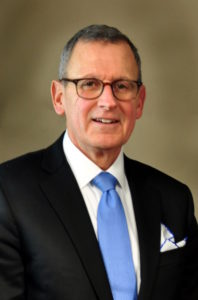All Eyes on the Leader
Leadership lessons learned from a press relations course May 2021Photo: iStock.com/spukkato

“Congratulations, you have been selected as the new chief of police. You start tomorrow.” I heard those words on June 11, 1992, when Mayor M. Gail Grimaldi informed me I would be the next chief of the police department in Pleasantville, New York. Thus, I began the most challenging and fulfilling leadership position of my personal and professional life.
At age 36—reportedly the youngest chief of police in New York at that time—I had some leadership experience under my belt from being a police sergeant, lieutenant and captain of a volunteer ambulance corps. The top chief position, however, represented something entirely different: Now I would be responsible for an entire police department and the safety of my community. I would be the face of the department and need to answer to multiple constituencies inside and outside of the department—all of whom had vastly different needs, concerns and agendas. To top it off, I would be doing it without any transitional leadership training. Congratulations, chief!
Where to Begin?
I knew I needed to get training relevant and specific to my new position and that this training also needed to be affordable to my municipal managers who would, in all likelihood, foot the bill. While I had a degree in criminal justice and would later pursue a master’s degree, I knew I needed training beyond the theoretical. I needed knowledge I could apply in those real-life situations leaders encounter on an almost-daily basis.
Fortunately, my new position afforded me access to a professional network of current and retired police chiefs who could give me insights into their work experiences and advice on where I should look for training opportunities. One of the first recommendations I received was from another recently appointed chief who made national and international headlines for a homicide in his community. He recommended that I enroll in a police press relations course since my job would entail a lot of contact with the press. I thought this was a great idea, discussed it with my mayor and ultimately enrolled in the exact same course.
Figuring Out Press Relations
I had taken a community relations course during my undergraduate studies in criminal justice. This type of training, however, was something entirely different. I signed up for the course and showed up for the first class. The course, which was held at a police agency in our county, was attended by about 10 other police personnel, most of whom were at the sergeant or lieutenant’s rank. I was the only chief in the room.
Following agency policy, I was dressed in what we in law enforcement term standard business attire—a suit and tie. The instructor, a former White House deputy press secretary, introduced himself and gave a quick overview of his experience as a journalist. He then asked each of us to introduce ourselves and tell the class what we did in our respective agencies, why we were taking the course and what we expected to get out of it. Each attendee responded with relatively brief answers to the questions, including their work and rank. Most were there because they held public information positions (PIO) within their agencies and would therefore need to interact with the press on a fairly regular basis.
Then my turn came. Knowing that as the only chief in the room, I would most likely be singled out for some reason or other, I kept my responses to the initial questions bland. “I’m employed by a local police agency and have 12 years of law enforcement experience. I work in uniform and would like to be more prepared should I need to speak to the press on behalf of my department.”
The instructor, sensing some hesitancy on my part, pressed a little harder (and mind you, he didn’t push harder with anyone else). “Well, what is it you do in uniform?” To which I replied, “Well, you know, just regular police work.”
That response was a mistake. This was a person trained to dig deep and ask probing questions. As he stood there, looking at me and no doubt formulating his next question, one of my esteemed classmates said rather nonchalantly, “He’s the chief.” With this comment, the instructor’s face broke into a wide smile, “Oh, the chief—very good.” And with that, he moved on to the next student—nothing more was said. I thought, well, that’s over and forgotten. Of course, I was wrong.
After our introductions and a description of the training agenda, the instructor proceeded with lecturing us for an hour on issues such as maintaining effective press liaisons, where to best conduct interviews (never in your office) and what would prove to be the most critical topic: how to write a proper press release. We then were given a fictional scenario involving a gas explosion at a large gas storage refinery that involved many unfortunate injuries and fatalities. Using the information provided, we were each to create a press release to provide to the local and national press. We had roughly 15 to 20 minutes to complete the exercise. While we were working on our assignment, the instructor and his assistant began setting up lighting, sound equipment and a video camera—equipment that had been packed in cases at the front of the room that I had not paid much attention.
In the Spotlight
After the equipment was set up and we had used up our time to develop our press releases, the instructor asked us to discuss the exercise and any problems we encountered in writing the release. This resulted in some back-and-forth between the class and the instructor, during which I was mostly silent, preferring to listen and learn. After that, the instructor indicated we would be putting our press releases to the test with a mock interview recorded on video and critiqued by him, his assistant and the class. His next words woke me up from my pre-lunch stupor: “Let’s have the chief come up since he’s the highest-ranking person in the room. You’re OK with that, right chief?” I wasn’t really, but if you’re going to be a leader, you might as well lead.
So, press release in hand, I went before the microphone and camera. Lights, camera, action! The instructor asked me to give the pretend viewing audience an update on the tragic incident that had just occurred and an update on our response. I put on my most commanding face and began to read the brief statement I had just prepared. About one-third of the way through, the instructor interrupted me and asked a question completely unrelated to the incident involving reports of political interference in the police department. He then thrust the microphone into my face expecting an answer.
After answering that question, he peppered me with multiple questions concerning reports of further political intrigue and extramarital affairs within the department, all of which were unrelated to the event—and not true—but clearly designed (although it wasn’t clear to me then) to make me angry and respond accordingly. I never got back to finishing my press release.
The instructor’s tactics worked magnificently. He pushed my buttons big time, and all of it was captured on video. After we finished, he thanked me for the interview, shut off the equipment and the group broke for lunch.
After lunch, we reconvened for the afternoon session, and the first order of business was to play back my heavily edited interview. To say that I looked like a lunatic would be an understatement. My comments and responses to the instructor’s questions were chopped up and pieced together to create a narrative far different than I intended.
After the very brief playback, we began the critique, and I expected to be heavily criticized by my classmates and the instructor. Surprisingly, I wasn’t. Every person in that room stated that they would have responded the same way—some even noted that they would have been more forceful in their responses. Indeed, that was the reason they were there in the first place—to learn how to accomplish a necessary task professionally.
Leadership Lessons Learned
Later in the course, I had the opportunity to reprise my role as an interviewee, but the lessons learned from that initial attempt stuck with me for a very long time—a lesson learned and never to be forgotten. Never again, even through aggressive questioning, did I ever lose my cool or stray from the message I wanted to get across to the public. When I recounted my experience to my colleague who recommended the course to me in the first place, he just laughed and said that was pretty much what happened in his class. Fortunately for him, the instructor chose another student to interview first.
My tenure as chief of police lasted 19 years. During that time, I conducted many press briefings where I stood before the camera to discuss happy events in our community and, sadly, too many tragedies. While I had the good fortune to participate in many leadership courses in subsequent years, the lessons learned from this first experience stayed with me throughout my entire tenure at the police department and into my post-retirement career.
The most important lesson, perhaps, is that leadership is multifaceted and occurs on many different planes. One of those planes is clear and effective communication. Certainly, with regard to press relations, one must understand that the public—the people we work for and hopefully work with us—is the ultimate consumer of the press. As chief of police, it was my responsibility to keep the public informed of both the good and bad that happened in the community. As leaders, it is important to accurately and succinctly convey critical information to our constituents in a personal and professional manner without being sidetracked.
Statements of fact and opinions expressed herein are those of the individual authors and are not necessarily those of the Society of Actuaries or the respective authors’ employers.
Copyright © 2021 by the Society of Actuaries, Schaumburg, Illinois.

